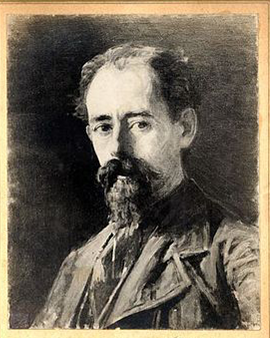Let's dive into the multifaceted life and unique artistic creation of Gioacchino Tomas (1836-1891), a master of historical, realistic and genre painting. The art of this important Italian teacher and painter, whose emotional depths only fully unfold against the backdrop of his life story, transports us to the sublime beauty of the Romantic style. In Tomas's later years, an intense biographical urge crystallized, finding expression in his autobiography, Memoirs of an Orphan. In this retrospective reflection, he described the crucial stages and experiences of his life - his deprived childhood, his inflexibility, his quest for redemption, and his civic and political involvement. This sincere and moving reflection on his career gave his work an unmistakable melancholy that made him known as "il pittore del grigio," the painter of horror.
Toma, son of a renowned doctor from Galatina, was orphaned at a young age and found his way to art almost on his own. After a brief period in a monastery and a poorhouse, where he took his first steps in drawing, he broke off all ties with his family at the age of 18 and fled to Naples. There he studied under the guidance of the painters Alessandro Fergola and Domenico Morelli, appropriating the art of painting ornaments and discovering his passion for the genre of still life painting. His commitment to revolutionary activities led him to join the ranks of Garibaldi and Matese before deciding to share his love of art in Naples and Florence by teaching in schools.
In his capacity as art teacher, professor at the Royal Academy of Fine Arts in Naples and director of the School of Applied Design, Toma gained wide recognition. His collections of lace designs were honored with a silver medal at the Esposizione Generale Italiana in Turin, and his writings on elemental design, which include a collection of plant drawings and other drawings in twenty plates, continue to enrich art appreciation today. Among his students were renowned artists such as the sculptor Giovanni de Martino and the painter Lionello Balestrieri. In recognition of his significant contribution to the art world, numerous streets throughout Italy, including two in Naples, were named after him.
Today, many years after Tomas' death in 1891, his works live on in the form of fine art prints that impressively reinterpret his powerful and haunting paintings. With great care, we reproduce these masterpieces to do justice to the unique character and depth of Tomas's art and make it accessible to a new audience. His captivating artworks, which tell of the pain and hope of his life, thus remain a permanent and indispensable part of Italy's artistic heritage.
×





_painting_-_(MeisterDrucke-1091453).jpg)
_painting_-_(MeisterDrucke-1091453).jpg)
.jpg)
.jpg)
.jpg)
.jpg)
.jpg)
.jpg)
.jpg)
.jpg)
.jpg)
.jpg)
.jpg)
.jpg)
.jpg)
.jpg)
.jpg)
.jpg)
.jpg)
.jpg)
.jpg)
.jpg)
_Luisa_Sanfelice_in_prison_P_-_(MeisterDrucke-949829).jpg)
_Luisa_Sanfelice_in_prison_P_-_(MeisterDrucke-949829).jpg)
_-_(MeisterDrucke-1088534).jpg)
_-_(MeisterDrucke-1088534).jpg)
.jpg)
.jpg)
.jpg)
.jpg)
.jpg)
.jpg)
.jpg)
.jpg)
.jpg)
.jpg)
.jpg)
.jpg)
_painting_-_(MeisterDrucke-1093122).jpg)
_painting_-_(MeisterDrucke-1093122).jpg)
.jpg)
.jpg)
.jpg)
.jpg)
.jpg)
.jpg)
.jpg)
.jpg)
.jpg)
.jpg)
.jpg)
.jpg)
_painting_-_(MeisterDrucke-1089415).jpg)
_painting_-_(MeisterDrucke-1089415).jpg)
.jpg)
.jpg)
.jpg)
.jpg)
.jpg)
.jpg)






